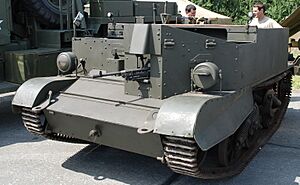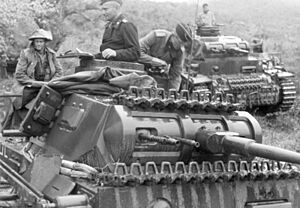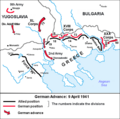19th Mechanized Division (Greece) facts for kids
Quick facts for kids 19th Mechanized Division19η Μηχανοκίνητη Μεραρχία |
|
|---|---|
| Active | 15 January – 10 April 1941 |
| Country | |
| Branch | |
| Type | Mechanized infantry |
| Part of | Eastern Macedonia Army Section |
| Engagements | World War II |
The 19th Mechanized Division was a special army unit from Greece. It was created on January 15, 1941, during World War II. This division was called "mechanized" because it used vehicles like trucks, tanks, and motorcycles to move its soldiers and equipment. However, because most of its soldiers rode in trucks, it's often called the 19th Motorized Division in English.
This division faced the German invasion of Greece on April 6, 1941. It helped protect the left side of the Greek army defending the strong forts of the Metaxas Line. The division fought bravely but was slowly broken apart by April 9. Its remaining soldiers surrendered on April 10, along with the rest of the Greek army in eastern Macedonia.
Contents
How the Division Was Formed
The idea for the 19th Mechanized Division came from Greece's first attempts to use machines in its army. This was back in the years between World War I and World War II. In 1931, Greece got its first tanks. These were two Vickers 6-Ton light tanks and two Carden Loyd tankettes. A tankette is like a very small tank.
At first, these vehicles were used for training. By 1935, they became part of a tank battalion. Greece hoped to get more tanks from Britain and France, but these countries needed the tanks for themselves when World War II started.
In 1937, a special unit called the Mechanized Cavalry Regiment was formed. It had 165 trucks, motorcycles, and other vehicles. But it didn't have any armored cars or tanks yet.
When the Greco-Italian War began in October 1940, the Mechanized Cavalry Regiment joined the fight. In December, they formed a Tank Company using 35 L3/35 tankettes they had captured from the Italians. At the same time, a Tank School opened in Athens to train Greek soldiers. Britain also sent some help: ten Light Tank Mk IIIB tanks, 100 Universal Carriers, and 185 Austin 8 cars with machine guns. A Universal Carrier is a small, open-topped armored vehicle that can carry soldiers or equipment.
With this new equipment, the Greek army decided to create the 19th Mechanized Division. This happened on January 15, 1941, in Athens. Major General Nikolaos Lioumbas was put in charge. The division was built around the Tank School and included the Mechanized Cavalry Regiment. It had about 8,000 soldiers, mostly from the cavalry. The plan was to have a full tank regiment and two mechanized infantry regiments, but there weren't enough tanks.
It took time for soldiers and officers to arrive from the front lines. The first parts of the division were ready by February 12. By late March, the division was mostly put together. However, it was still not fully ready for battle. There were not enough spare parts for the vehicles. One British commander said the division was made of "recently enlisted garage hands" and had "no possible prospect of fighting usefully."
The Division in Battle
The 19th Mechanized Division's first job was to protect a line of mountains, helping to shield the British "W Force" as it got ready. But then, on March 20, the division was moved north to the area around Lake Doiran. Its new job was to watch out for enemy paratroopers.
On March 28–29, as the German invasion got closer, the division moved even further northeast. It came under the command of the Eastern Macedonia Army Section. Some of its units, like the Italian tankette companies, were sent to Thessaloniki for anti-paratrooper duties. Other units were sent to different areas to act as reserves or to help defend specific lines.
Facing the German Attack
On April 6, 1941, the German army began its attack. The 19th Mechanized Division took up positions to cover the left side of the Greek army. They were reinforced by the Krousia Detachment, which included the 2nd Cavalry Regiment. The division's command post was in Kilkis. The front line they had to defend was very long, about 30 kilometers. They had too few soldiers and guns to cover it well. Also, communication between units was difficult, and German planes were a big threat to their vehicles.
In the afternoon, German planes bombed the 192nd Regiment. Many soldiers were killed or wounded, and several vehicles were destroyed. Despite this, the regiment reached its assigned positions. The 193rd Regiment had better luck, reaching its area without major problems. That night, Greek patrols reported German soldiers moving along the railway tracks.
German Breakthrough
On April 7, the Germans attacked again, but the Greek forces pushed them back. However, news came that the Yugoslav army to the north was collapsing. This meant German forces could go around the Greek army through the Vardar River valley. The 19th Division was ordered to extend its front line to the west to close this gap. They took over more troops and were reinforced, but this stretched them even thinner. The division now had to defend a front line about 50 kilometers wide.
On April 8, the situation became very difficult. The 19th Reconnaissance Group and parts of the 193rd Regiment moved to a new area called Akritas. But German forces, with tanks and air support, attacked them early in the morning. The Greek soldiers fought back, reporting two enemy tanks destroyed, but they had to retreat. The Germans captured Akritas, which allowed them to attack the Greek positions from behind. Many Greek units became surrounded.
The 192nd Regiment, trying to reach Akritas, was also attacked by a German column and forced to pull back. Other Greek units were captured or scattered. By 10:30 AM, the left side of the division was cut off, and the Germans had broken through. Orders to retreat caused more confusion, with some units staying and others leaving.
The End of the Division
By April 9, the division was falling apart. The Germans captured Kilkis and entered Thessaloniki. The division commander, Major General Lioumbas, moved his command post. He ordered his remaining units to retreat southeast.
The mechanized parts of the 192nd Regiment arrived at Elliniko first. Other units from the Krousia area also tried to retreat there. However, the 193rd Regiment was attacked from both sides by the Germans. After a short fight, the commander ordered his soldiers to surrender.
Finally, on the afternoon of April 10, the remaining parts of the 19th Mechanized Division surrendered to the Germans in Serres. The division's commander and a few officers managed to escape. The 191st Regiment, which had not been heavily involved in the main battle, also broke apart, with its soldiers scattering. This marked the end of the 19th Mechanized Division as a fighting force.
Legacy
The Greek Army sees the 19th Mechanized Division as its first important mechanized unit. It is considered the ancestor of the modern Greek Armour combat arm, which is the part of the army that uses tanks and armored vehicles.
Images for kids






